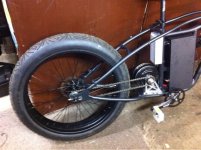bØb
1 W
Whiplash said:Oh OK I need yo get mine apart, its just too hard to visualize with only pics...
In a nut shell:
1> Run the motor before you take it apart and void the warranty :wink: You can hold the motor vertically or horizontally in a vise by the brake axle flats.
2> Remove nuts and etc from both ends of the axle. Clamp the brake side axle vertically in a vise.
3> Remove the freewheel side cover.
4> Push the hub and brake side cover and hub center section off the motor guts. Do this with your hands. Leave these pieces on the axle on top of the vise.
5> Remove the Case and guts from the vise. Slide the hub and cover down to the end. Don't try to take it off, just lay it on the bench (the one the vise is attached to
6> Put the guts back in the vise, with the brake side axle up.
7> Remove the circlip, clutch, key and the washer. The clutch is not real tight, but is hard to get a hold of. You may need a 3 leg gear puller, but you can turn the gear puller screw with you hand. If you can't, you probably forgot something
8> Take the guts out of the vise again and put the brake side axle in the vise again. I know this seems like a lot of flipping, but with my 20 20 hindsight, I can see it is the easiest method.
9> Cut all the wires in the cable now. Be sure to leave a little bit of wire on all the connections so you can identify them later. You are now committed
10> Remove the circlip and six screws that hold the little cover over the wires and key the stator holder to the axle. You may have to remove some excess epoxy and bend some wires a little. The epoxy they used seem to be super quick setting and is quite brittle. When you remove these screws, there is nothing supporting the motor. Drop it down the axle and set it on a rag wrapped around the axle. If it doesn't fall free, bump the stator with you hand or rock it a little. The little plate will be held by the key.
11> Remove the little plate and the key. You might be able to pull it off by hand, if you can get hold of it. If not use the gear puller. If it pulls hard you forgot the circlip in step 10.
12> Cut the end of the cable stub flush to the axle and slid the motor off the axle. It is a good idea to keep the motor in a container to keep it from grabbing up all kinds of steel trash in the shop. I kept mine in a small plastic paint pail with a lid on it except when I was measuring something on it.
13> Clamp the freewheel side of the axle horizontally by the flats and jerk the big end of the cable out of the axle. I'm not going to use the phase wires out of mine. I have 10 ga. silicone wire to use for that, but I will probably use the hall effect sensor wires and temperature wire and put them in a heat shrink tube.
I'm ready to go to bed,
bØb




